ASUS Rampage II Extreme - First Look
by Gary Key on October 9, 2008 12:00 PM EST- Posted in
- Motherboards
The Board
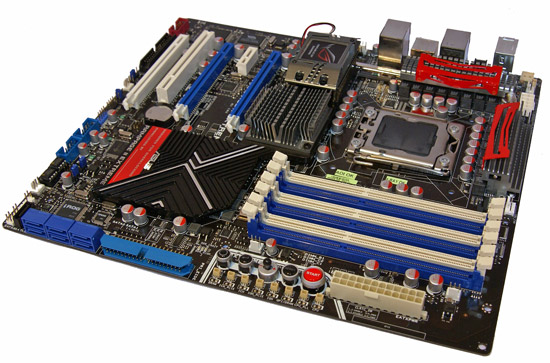
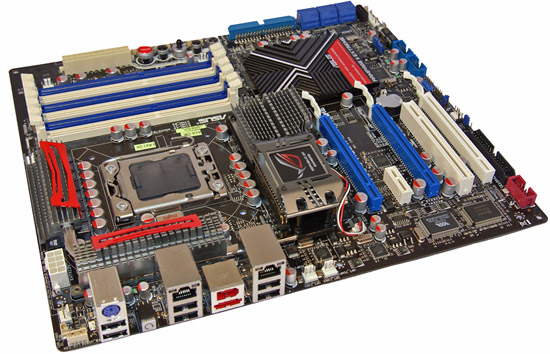
The apple did not fall far from the tree when comparing this latest ROG design to the previous Maximus Formula II and Rampage Extreme boards. We have the return of an eight-layer board dressed out in our favorite black, silver, and Ferrari red color scheme. The memory and peripheral slots return in a blue and white motif with the first PCI Express x1 slot that usually houses the SupremeFX X-FI audio card sporting black.
Due to the new LGA 1333 (Socket B1) design being larger than the current LGA 775, along with six DIMM slots, the area around the CPU is crowded. This results in a creative layout that manages to squeeze all the options into a slightly extended ATX format. However, the layout just does not look as clean as previous ROG offerings to us, even though it is still aesthetically pleasing. We do think ASUS should have dropped the floppy connector; in fact, except for certain business environments, we think it is time to kill the floppy. ASUS throws in seven fan headers that can be controlled and monitored in the BIOS or via a Windows utility program.
ASUS will either include the current LCD Poster that displays system information during POST along with voltage, temperature, or fan speed data. We hope they include the new OC Palm system on the P6T boards that features a full color 320x240 pixel LCD screen that offers the same monitoring features of the LCD Poster or overclocking on the fly controls that are easier to use than the toggle switches.
Around the Rectangle
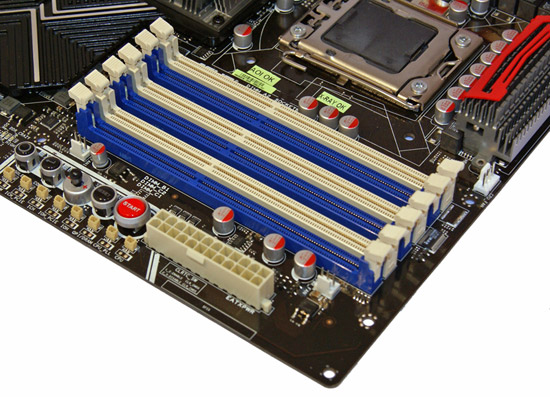
Six DDR3 DIMM slots are included for tri-channel goodness. Performance and compatibility is currently better when utilizing the blue slots. The memory subsystem receives a three-phase power delivery system.
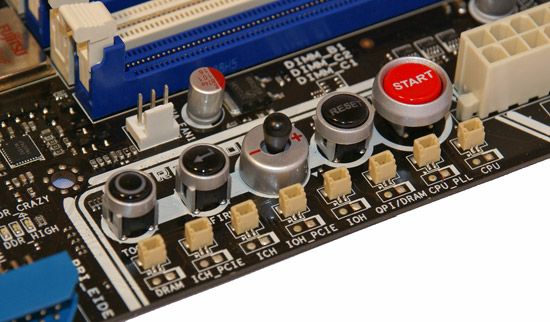
The TweakIT toggle and power/reset switches carry over from the Rampage Extreme board. This system lets you overclock on the fly from within Windows or even during applications when the CPU is loaded. Eight different solder points and pin-outs allow multimeter readings of DIMM, ICH, ICH PCIe, IOH, QPI, CPU PLL, and Core voltages.
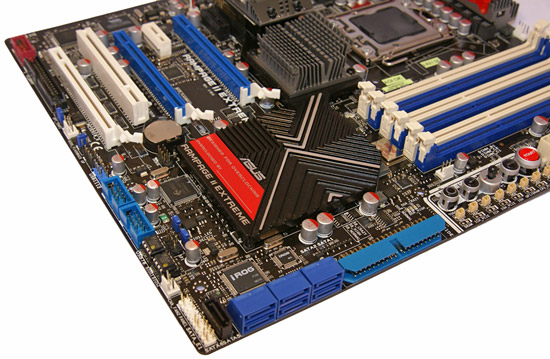
The ICH10R Southbridge is utilized and provides the six SATA ports (dark blue) along with RAID 0, 1, 5, and 10. For some odd reason ASUS reverted to the JMicron JMB363 for an extra SATA port (black), an eSATA port on the IO panel, and IDE duties. We prefer the Marvell or ITE controllers for compatibility and performance reasons. The iROG chipset returns and offers the same features as before: on-board LED control, time keep function, BIOS flashback, additional voltage controls, and a temperature based protection scheme if you enable it.
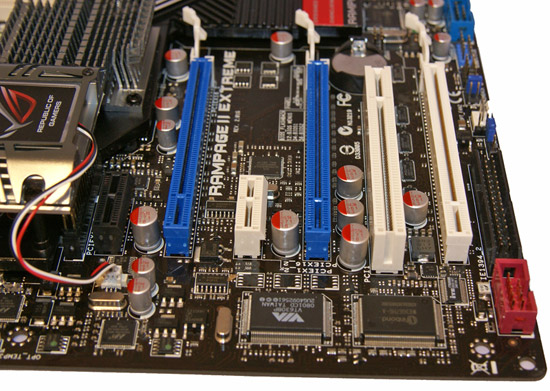
ASUS includes two PCI Express x1 slots, three x16 PCIe 2.0 slots (dual x16 or x16/x8/x8), and a lonely PCI slot. CrossFire and SLI support will be included, but we do not know if Tri-SLI will make an appearance or not. If you utilize double slot GPU cards, the second PCIe x1 slot and the PCI slot will be physically unavailable with a CF or SLI setup.
The black PCIe x1 slot doubles as the HD Audio slot that features the ADI SoundMAX 2000a chipset with support for Creative X-Fi 4.0 routines via a software implementation. This is the last hurrah for the ADI chipset as they have exited the on-board audio business, but they will continue to provide support into the near future. This is good news for Realtek and bad news for users wanting a fairly decent and "free" on-board audio solution.
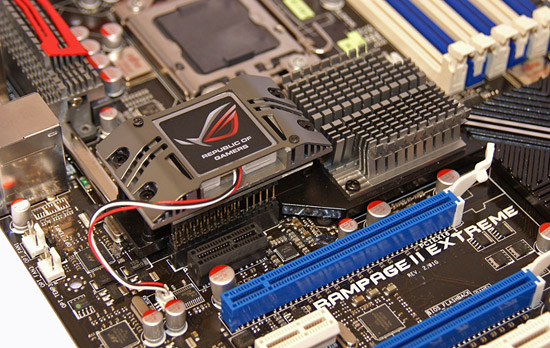
Below the ROG silkscreen (backlighted for your viewing pleasure) is the VTT CPU Power Card that we will investigate further in the full article. The second heatsink is for the X58 chipset and works quite well in early testing. However, if you are running a CF or SLI setup and need the first PCIe x1 slot for audio or other purposes, you are out of luck as the last set of fins on the heatsink blocks full-length cards. We hope that ASUS will address this before commencing retail production.
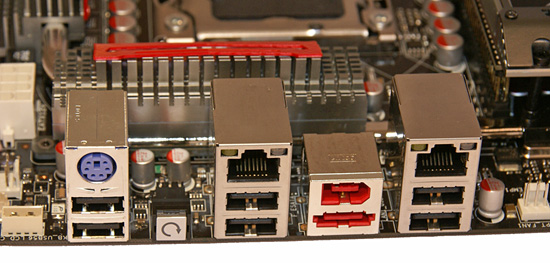
The IO panel is a standard design and almost legacy free. The PS/2 keyboard port is a nod to the overclocking crowd as is the clear CMOS switch. Six USB 2.0 port are available along with six more via headers on the motherboard. An IEEE 1394a port courtesy of the very fast VIA VT8309P chipset and the eSATA port via JMicron's JMB363 are included along with dual RJ-45 ports sporting the Marvell 88E8056-NNC1 controller chips that offer teaming capability.
















35 Comments
View All Comments
piroroadkill - Friday, October 10, 2008 - link
As much as I agree that Firewire 800 is really really awesome (it is); it's so seldom used that it may as well barely exist compared to USB. At least Firewire 400 had some initial exposure when that's all DV Cams supported.takumsawsherman - Friday, October 10, 2008 - link
Ah, but they still have the firewire port, don't they? So giving you the port, they give you the old one. Also, eSATA is pretty much storage only, and the connectors still leave something to be desired, vs. the very durable Firewire 800 cable.When you are paying $300 for a board, would it also not bother you if they had a USB 1.1 port for use with the Keyboard and Mouse, because you don't *need* 480Mbps for a keyboard and mouse. Unless, of course, you had other plans for your USB ports.
Speaking of USB being slow, the speed of hard drives, scanners and the like over USB is horrible. If you are copying large files, or ghosting/acronising a machine, firewire is where it's at. While I have a couple of enclosures that have eSATA, most customers don't have eSATA, and the Macs all have FW800. This makes cloning faster, and I can service more systems in a day when I am not waiting extra time for patches to copy over, etc.
Every Mac besides the Mini has FW800. That includes the $1200 iMac. When we are talking $300/board, they can be gracious and give you the best there is, not cutting corners at every opportunity.
3DoubleD - Friday, October 10, 2008 - link
Honestly, who cares about Firewire? USB offers 60 MB/s, which is more than enough for anything (flash drives, devices) except hard drives. In the case of hard drives, use an eSATA port for 300 MB/s. If you care about Firewire that much, buy a firewire card, you are in the small minority of users who actually use it. USB is the standard and when USB 3.0 is released Firewire800 will be completely forgotten (if that hasn't happened already).bigboxes - Friday, October 10, 2008 - link
Thank you. I remember some years back when I was building a pc that would do everything. I just had to have all the peripherals so naturally I had to install a four-port firewire card. You guessed it. I never used it. When it came time to upgrade my box I never put the thing back in. USB is definitely the standard and between eSATA and USB 3.0 you are never gonna need Firewire800 again.CEO Ballmer - Friday, October 10, 2008 - link
Works best when running Vista Ultimate though!http://fakesteveballmer.blogspot.com">http://fakesteveballmer.blogspot.com
Mclendo06 - Thursday, October 9, 2008 - link
So, the release date is under NDA, huh?Let me put it to you this way...
When might you be able to tell us the release date?
Or, if that doesn't work...
When could you tell us about being able to tell us about the release date?
Feel free to take as many steps as is necessary to throw Intel's lawyers off your tail.
Clockw0rk - Thursday, October 9, 2008 - link
The original Rampage Extreme seemed like it was designed with water cooling in mind -first- and air cooling after. Maybe this falls into NDA territory, but can we confirm that water blocks will come with the board?AmberClad - Thursday, October 9, 2008 - link
The heatsink is under NDA too?Why are you guys not permitted to say anything as far as the cooling results with that Vigor Monsoon heatsink? Or does that fall under i7 itself, and its TDP and thermal characteristics?
Nfarce - Thursday, October 9, 2008 - link
A minimum entry fee of $250 to join the i7 Club starting with the chipset? Not too bad for a high end rig, especially considering what high end X48 and 790i chipsets are going for now. AT, can you give us an idea of when we'll see a full test? If, as you hint, it's between tomorrow and next month before retail release on all this hardware, It's obvious people out there waiting for a new build decision, myself included, would consider the performance increase over the current platform as what would make their buying decisions, irrespective of when they know it would actually be available.Nfarce - Thursday, October 9, 2008 - link
Oops, I forgot to add that I'm also using a two year old rig, a P965/E6600 set up. If i7 real world (gaming) performance over a very affordable P45/E8xxx current build is only about 10-15% difference yet has a 25-35% cost increase, I'll pull the NewEgg trigger for the former. This waiting is torture I tell ya!